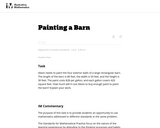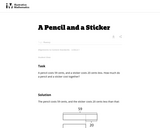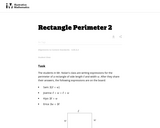
This real world word problem requires multiple steps.
- Subject:
- Mathematics
- Material Type:
- Activity/Lab
- Provider:
- Illustrative Mathematics
- Provider Set:
- Illustrative Mathematics
- Author:
- Illustrative Mathematics
- Date Added:
- 05/01/2012

This real world word problem requires multiple steps.

The purpose of this task is to provide students an opportunity to use mathematics addressed in different standards in the same problem.

This word problem requires students to use addition and subtraction and think about money.

These word problems represent the "Add To" contexts for addition and subtraction.

This tasks gives a verbal description for computing the perimeter of a rectangle and asks the students to find an expression for this perimeter. Students then have to use the expression to evaluate the perimeter for specific values of the two variables.

This task is a natural follow up for task Rectangle Perimeter 1. After thinking about and using one specific expression for the perimeter of a rectangle, students now extend their thinking to equivalent expressions for the same quantity.

The purpose of this task is for students to compare two fractions that arise in a context. Because the fractions are equal, students need to be able to explain how they know that.

This word problem asks students to think about fractions.

This word problem may be used for instructional or assessment purposes, depending on where students are in their understanding of addition and how the teacher supports them.

There are a couple of ways to solve this real world word problem.

Students gain experience and practice with three types of word problems using the "Take From" context: result unknown, change unknown, and start unknown.

This word problem is based estimating the height of a person over time. Note that there is a significant amount of rounding in the final answer. This is because people almost never report their heights more precisely than the closest half-inch. If we assume that the heights reported in the task stem are rounded to the nearest half-inch, then we should report the heights given in the solution at the same level of precision.

This task uses language, "half of the stamps," that students in Grade 5 will come to associate with multiplication by the fraction 12. In Grade 3, many students will understand half of 120 to mean the number obtained by dividing 120 by 2. For students who are unfamiliar with this language the task provides a preparation for the later understanding that a fraction of a quantity is that fraction times the quantity.

This is a video and interactive assessment activity designed to help first graders learn about subtraction word problems up to twenty.

This course features a video review and an assessment practice of subtracting by crossing out with pictures for word problems. It is aimed at first grade math students.

Systems of Equations word problems.

This resource is from Tools 4 NC Teachers. This provides resources to help teachers establish a classroom culture focused on effective mathematics dispositions early in the year. This item can be remixed!

This resource is from Tools 4 NC Teachers. It provides several number talks for teachers to do with their students. The content aligns with Grade 3, Cluster 1. In the notes section there are suggestions for doing the Number Talk with students. The resource can be remixed!

This is from Tools 4 NC Teachers. This resource provides more practice problems related to 3.OA.8, two step problems. This is aligned to concepts in Cluster 1. This can be remixed.

This resource is from Tools 4 NC Teachers. It provides extra two-step word problems aligned to 3.OA.8. It is remixable but please provide an answer key to any problems you provide.